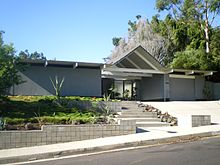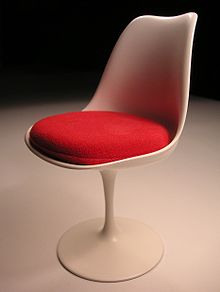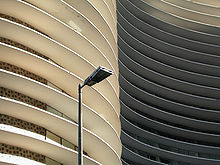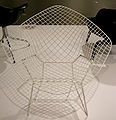- Mid-Century modern
-
Mid-Century modern is an architectural, interior and product design form that generally describes mid-20th century developments in modern design, architecture, and urban development from roughly 1933 to 1965. The term, employed as a style descriptor as early as the mid-1950s, was reaffirmed in 1983 by Cara Greenberg in the title of her book, Mid-Century Modern: Furniture of the 1950s (Random House), celebrating the style which is now recognized by scholars and museums worldwide as a significant design movement.
Contents
Architecture
Mid-century architecture was a further development of Frank Lloyd Wright's principles of organic architecture combined with many elements reflected in the International and Bauhaus movements - including the work of Gropius, Le Corbusier, and Mies van der Rohe. Mid-century modernism, however, was much more organic in form and less formal than the International Style. Brazilian and Scandinavian architects were very influential at this time, with a style characterized by clean simplicity and integration with nature. Like many of Wright's designs, Mid-Century architecture was frequently employed in residential structures with the goal of bringing modernism into America's post-war suburbs. This style emphasized creating structures with ample windows and open floor-plans with the intention of opening up interior spaces and bringing the outdoors in. Many Mid-century houses utilized then-groundbreaking post and beam architectural design that eliminated bulky support walls in favor of walls seemingly made of glass. Function was as important as form in Mid-Century designs, with an emphasis placed specifically on targeting the needs of the average American family. Examples of residential Mid-Century modern architecture are frequently referred to as the California Modern style.
 Eichler Homes - Foster Residence, Granada Hills
Eichler Homes - Foster Residence, Granada Hills
In Europe the influence of Le Corbusier and the CIAM resulted in an architectural orthodoxy manifest across most parts of Post War Europe that was ultimately challenged by the radical agendas of the architectural wings of the avant-garde Situationist International, COBRA, as well as Archigram in London. A critical but sympathetic reappraisal of the internationalist oeuvre, inspired by Scandinavian Moderns such as Alvar Aalto, Sigurd Lewerentz and Arne Jacobsen and the late work of Le Corbusier himself was reinterpreted by groups such as Team X including structuralist architects such as Aldo van Eyck, Ralph Erskine, Denys Lasdun, Jorn Utzon and the movement known in the UK as New Brutalism.
Pioneering builder and real estate developer Joseph Eichler was instrumental in bringing Mid-Century Modern architecture ("Eichler Homes") to subdivisions in the Los Angeles area and the San Francisco Bay region of California and select housing developments on the east coast. George Fred Keck, Henry P. Glass and Ludwig Mies van der Rohe created Mid-Century Modern residences in the Chicago area. Mies van der Rohe's Farnsworth House is extremely difficult to heat or cool, while Keck and Keck were pioneers in the incorporation of passive solar features in their houses to compensate for their large glass windows.
Industrial design
Scandinavian design was very influential at this time, with a style characterized by simplicity, democratic design and natural shapes. Glassware (Iittala - Finland), ceramics (Arabia - Finland), tableware (George Jensen - Denmark), lighting (Poul Henningsen - Denmark), and furniture (Danish modern) were some of the genres for the products created.
Edith Heath (1911–2005) was an industrial designer, potter, and founder of Heath Ceramics in 1948. The company, well known for its Mid-Century modern ceramic dish-ware (Heathware) and architectural tiles, is still operating out of Sausalito, in Marin County of the San Francisco Bay Area, California. Edith Heath's "Coupe" line remains in demand and has been in constant production since 1948, with only periodic changes to the texture and color of the glazes.[1]
Examples
Furniture
Architecture
-
Main Terminal at Dulles Airport in Northern Virginia, by Eero Saarinen
-
North Christian Church, Columbus, Indiana, US, the final work of Eero Saarinen
-
Stahl House, designed by Pierre Koenig
-
Helsinki, Finland - University of Technology - Auditorium, by Alvar Aalto.
-
Hotel Casino de la Selva, Cuernavaca, Mexico, by Félix Candela
-
Cal Poly Pomona College of Environmental Design by Carl Maston
Well-known designers of the mid-century modern era
- Alvar Aalto
- Milo Baughman
- Al Beadle
- Harry Bertoia
- Marcel Breuer
- William Burgess
- Chris Choate
- William E. Cody
- Edward Dart
- Thomas Scott Dean
- Charles and Ray Eames
- Joseph Eichler
- Craig Ellwood
- Arthur Erickson
- O'Neil Ford
- Paul T. Frankl
- Albert Frey
- Henry P. Glass
- Mendel Glickman
- Bertrand Goldberg
- Max Gottschalk
- Eileen Gray
- Jerry Gropp
- Ralph Haver
- Edith Heath
- Poul Henningsen
- Edward Humrich
- A.J. Iversen
- Arne Jacobsen
- George Jensen
- A. Quincy Jones
- Finn Juhl
- Vladimir Kagan
- Louis Kahn
- George Fred Keck & William Keck
- Poul Kjaerholm
- Kaare Klint
- Pierre Koenig
- William Krisel
- Ib Kofod-Larsen
- Denys Lasdun
- Mogens Lassen
- John Lautner
- Roger Lee
- Carl Maston
- Cliff May
- Paul McCobb
- John Randal McDonald
- Ludwig Mies van der Rohe
- Børge Mogensen
- George Nelson
- Richard Neutra
- Oscar Niemeyer
- Isamu Noguchi
- Verner Panton
- Tony Paul, his web site
- Adrian Pearsall
- William Pereira
- Warren Platner
- Harvey Probber
- Jens Risom
- Paul Rudolph
- Eero Saarinen
- Rudolf Schindler
- Paul Schweikher
- Avriel Shull
- Richard Schultz
- Maurice K. Smith
- Alison and Peter Smithson
- Raphael Soriano
- Ole Wanscher
- Hans Wegner
- Donald Wexler
- Russel Wright
- Eva Zeisel
See also
References
- ^ Zahid Sardar (2004-02-01). "Home Is Where the Heath Is: A Bay Area pottery tradition continues under new ownership". San Francisco Chronicle. http://www.sfgate.com/cgi-bin/article.cgi?file=/chronicle/archive/2004/02/01/CMGH94KDCV3.DTL. Retrieved 2006-09-14.
http://midcenturymodernonline.com
Modern architecture Art Deco (1925–1939) · Art Nouveau (1890–1905) · Bauhaus (1919–1933) · Blobitecture (1960s–) · Brutalism (1950s–1980s) · Constructivism (1920–1932) · Contemporary (2000–) · Critical regionalism · De Stijl (1917–1931) · Deconstructivism (1980s–) · Expressionism (1910–) · Functionalism (1920s–1970s) · Futurism (1920s–) · Googie (1940s–1960s) · High-tech (1970s–) · International style (1920s–1960s) · Mid-Century modern (1940s–1960s) · Modernisme (1888–1911) · Neomodern (1990s–) · New Objectivity (1922–1933) · Organicism (1920s–) · Postconstructivism (1930s) · Prairie School (1890s–1920s) · Postmodernism (1960s–) · Rationalist-Fascist (1920s–1930s) · Streamline Moderne (1926–1950s) · Stalinist (1930s–1950s) · Structuralism (1959–)
Related articles Categories:- American architectural styles
- Architectural styles
- History of furniture
- House styles
- Modernist architecture in the United States
- Modernist architecture
Wikimedia Foundation. 2010.
















